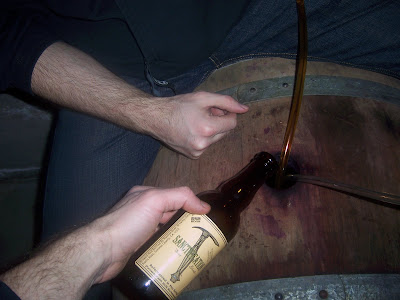
Wow, about 2 months since my last post! That's a record I think. One of the reasons why is that I have decided to wait to post recipes until I do the tasting too. So I have been brewing, but the posts will go up later.
For this beer, I was looking to make a beer that would be reminiscent of an Ayinger lager, especially their Oktoberfest, although once again I did not have their exact lager strain (which would be the Wyeast "Hella Bock" seasonal strain). I wanted it to be dark, melanoidin rich, and slightly sweet, with a big flavor profile but low alcohol. I wasn't looking to make a lager "to style", but I think it's a great example of a Munich Dunkel.
TASTING NOTES:
Appearance: Dark brown with a stable tan head that leaves a great lacing. Ruby highlights, clear but not "filtered" clear.
Aroma: Dark toasted breadcrusts, with a slight fruity sweetness from crystal malts. Very little to no hop aroma, slight alcohol contribution. Robust maltiness and a clean lager profile with maybe just a touch of sulfur (which dissipated as beer spent more time lagering).
Flavor: Toasty, Munich malt derived breadcrust, Moderate sweetness, low caramel flavor, but balanced more towards toasty flavors from malts. Moderate bitterness, very clean. Slight trace of hop flavor, then it ends with dry, toasty malt and clean residual bitterness.
Mouthfeel: Medium bodied, a little chewy, hearty enough for winter or fall but not too thick or filling. Moderate carbonation, low alcohol warmth, dry finish with just a touch of astringency.
Overall: This beer is a hit with Clarissa, who has a high appreciation for drinkable, flavorful session beers (you know, the kind us beer geeks think are "boring" and hardly ever brew). I like it a lot, and it's very close to what I was going for, but still I see room for improvement. I'd like to reduce the "bready" impact just a touch, and increase the perception of a light sweetness by dropping the IBU's just a touch. It's a great "dinner" beer, and you can have an imperial pint and go back for another. This keg definitely won't last long.
Recipe: Session amber lager
Recipe Specifications
--------------------------
Batch Size (fermenter): 6.00 gal
OG: 1.048
FG: 1.015
ABV: 4.3%
Estimated Color: 15.5 SRM
Estimated IBU: 23.1 IBUs
Mash Efficiency: 88.00 %
Boil Time: 90 Minutes
Ingredients:
------------
5 lbs 8.0 oz Pilsner (2 Row) Ger (2.0 SRM) Grain 1 61.5 %
2 lbs Munich Malt - 10L (10.0 SRM) Grain 2 22.4 %
8.0 oz Melanoiden Malt (20.0 SRM) Grain 4 5.6 %
12.0 oz Caramunich Malt (56.0 SRM) Grain 3 8.4 %
3.0 oz Carafa III (525.0 SRM) Grain 5 2.1 %
17.00 g Perle [7.10 %] - First Wort 90.0 min Hop 6 19.2 IBUs
14.00 g Perle [7.10 %] - Boil 15.0 min Hop 7 3.8 IBUs
1.0 pkg Bohemian Lager (Wyeast Labs #2124) [124. Yeast 8 -
Notes:
------
4 gallons water, 1 gr. gypsum, 2 gr. CaCl, 2 gr. CaCO3
Mash in to 125F, 15 min.
Raised to 153 over 10 min, hold 30 min
Raised to 158 over 5 min, hold 15 min
Raised to 168 over 5 min, rest 5 min
sparge w/ 5 gal at 168 (no minerals)
Collect 6.8 gallons at 1.044
Boil 90 minutes, yeast nutrient and whirlfloc at 10 min.
End of boil: top up to 6 gallons (hot)
whirlpool & rest 10 min
chill thru plate chiller to 62
2 min O2
leave in garage at ambient temp (48) until visible fermentation
cooled to 50 degrees by 8 hours and visibly fermenting
fermented at 48-50 for 2 weeks
brought inside for diacetyl rest (65ish) for 1 week
11/23 Racked to keg, aged 3 weeks at 35 before drinking
Starter: 3750 ml stirplate starter 4 days ahead at room temp, decanted. Bohemian Lager yeast.
































